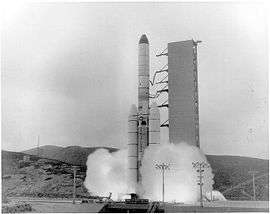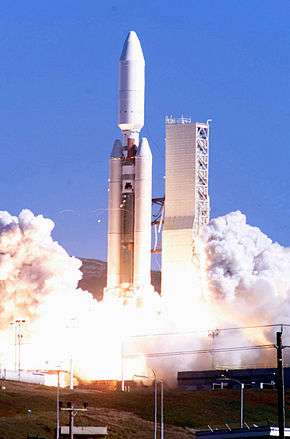Titan IIID
 Launch of a Titan IIID | |
| Function | Expendable launch system |
|---|---|
| Manufacturer | Martin Marietta |
| Country of origin | United States |
| Size | |
| Height | 36 m (118 ft) |
| Diameter | 3.05 m (10.0 ft) |
| Mass | 612,990 kg (1,351,410 lb) |
| Stages | Two |
| Capacity | |
| Payload to LEO | 12,300 kg (27,100 lb) |
| Associated rockets | |
| Family | Titan |
| Launch history | |
| Status | Retired |
| Launch sites | SLC-4E, Vandenberg AFB |
| Total launches | 22 |
| Successes | 22 |
| First flight | 15 June 1971 |
| Last flight | 17 November 1982 |
| Boosters (Stage 0) – UA1205 | |
| No. boosters | Two |
| Thrust | 5,849 kN (1,315,000 lbf) |
| Specific impulse | 263 sec |
| Burn time | 115 seconds |
| Fuel | Solid |
| First stage | |
| Engines | 2 LR87-11 |
| Thrust | 2,340 kN (530,000 lbf) |
| Specific impulse | 302 sec |
| Burn time | 147 seconds |
| Fuel | A-50/N2O4 |
| Second stage | |
| Engines | 1 LR91-11 |
| Thrust | 454 kN (102,000 lbf) |
| Specific impulse | 316 sec |
| Burn time | 205 seconds |
| Fuel | A-50/N2O4 |
The Titan IIID or Titan 3D was an American expendable launch system, part of the Titan rocket family. Titan IIID was flown 22 times with KH-9 and KH-11 satellites between 1971 and 1982, all successful launches.[1] Essentially a Titan IIIC with the Transstage removed, it was designed for heavy LEO payloads.
The Titan IIID first flew on 15 June 1971, launching the first KH-9 satellite.[2] It was retired from service in 1982, and replaced by the uprated Titan 34D. All launches occurred from Space Launch Complex 4E at Vandenberg Air Force Base.
Launch history
| Date/Time (GMT) | Launch Site | S/N | Payload | Outcome | Remarks |
|---|---|---|---|---|---|
| 15 June 1971 18:41 |
VAFB LC-4E | 3D-1 | OPS-8709 (KH-9) | Successful | |
| 20 January 1972 18:36 |
VAFB LC-4E | 3D-2 | OPS-1737 (KH-9) | Successful | |
| 7 July 1972 17:46 |
VAFB LC-4E | 3D-5 | OPS-7293 (KH-9) | Successful | |
| 10 October 1972 18:03 |
VAFB LC-4E | 3D-3 | OPS-8314 (KH-9) | Successful | |
| 9 March 1973 21:00 |
VAFB LC-4E | 3D-6 | OPS-8410 (KH-9) | Successful | |
| 13 July 1973 20:22 |
VAFB LC-4E | 3D-7 | OPS-8261 (KH-9) | Successful | |
| 10 November 1973 20:12 |
VAFB LC-4E | 3D-8 | OPS-6630 (KH-9) | Successful | |
| 10 April 1974 20:20 |
VAFB LC-4E | 3D-9 | OPS-6245 (KH-9) | Successful | |
| 29 October 1974 19:30 |
VAFB LC-4E | 3D-4 | OPS-7122 (KH-9) | Successful | |
| 8 June 1975 18:30 |
VAFB LC-4E | 3D-10 | OPS-6381 (KH-9) | Successful | |
| 4 December 1975 20:30 |
VAFB LC-4E | 3D-13 | OPS-5547 (KH-9) | Successful | |
| 8 July 1976 18:30 |
VAFB LC-4E | 3D-14 | OPS-4699 (KH-9) | Successful | |
| 19 December 1976 18:19 |
VAFB LC-4E | 3D-15 | OPS-5705 (KH-11) | Successful | |
| 27 June 1977 18:30 |
VAFB LC-4E | 3D-17 | OPS-4800 (KH-9) | Successful | |
| 26 March 1978 18:40 |
VAFB LC-4E | 3D-20 | OPS-0460 (KH-9) | Successful | |
| 14 June 1978 18:23 |
VAFB LC-4E | 3D-18 | OPS-4515 (KH-11) | Successful | |
| 16 March 1979 18:30 |
VAFB LC-4E | 3D-21 | OPS-3854 (KH-9) | Successful | |
| 7 February 1980 21:10 |
VAFB LC-4E | 3D-19 | OPS-2581 (KH-11) | Successful | |
| 18 June 1980 18:30 |
VAFB LC-4E | 3D-16 | OPS-3123 (KH-9) | Successful | |
| 3 September 1981 18:29 |
VAFB LC-4E | 3D-22 | OPS-3984 (KH-11) | Successful | |
| 11 May 1982 18:35 |
VAFB LC-4E | 3D-24 | OPS-5642 (KH-9) | Successful | |
| 17 November 1982 21:18 |
VAFB LC-4E | 3D-23 | OPS-9627 (KH-11) | Successful |
References
- ↑ Krebs, Gunter. "Titan-3D". Gunter's Space Page. Retrieved 2009-01-25.
- ↑ Wade, Mark. "Titan". Encyclopedia Astronautica. Retrieved 2009-01-25.
External links
![]()
This article is issued from
Wikipedia.
The text is licensed under Creative Commons - Attribution - Sharealike.
Additional terms may apply for the media files.
